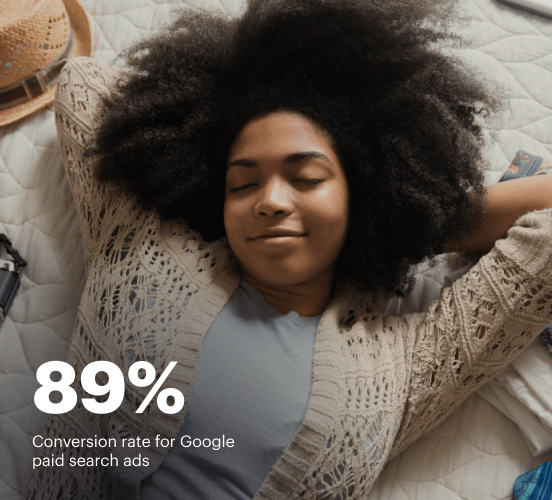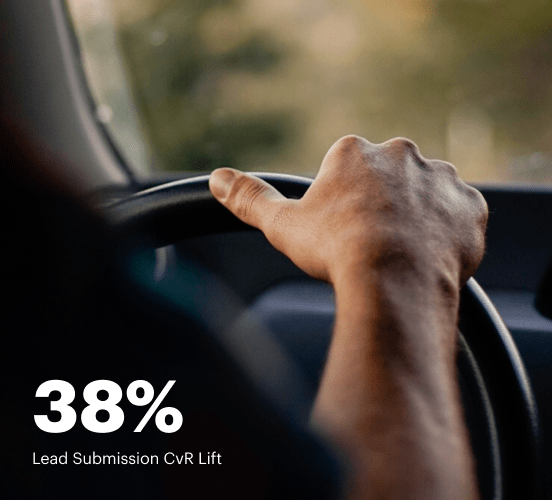HubSpot vs. Adobe Target: the best platform for a seamless web experience
Discover how HubSpot compares to Adobe Target regarding features and usability. Find out which platform provides the competitive advantage your business deserves.
Get startedSee how Instapage stacks up against the competition
| Feature | Instapage | Other builders |
| Drag-and-Drop Tools | ||
| Conversion-optimized templates | ||
| Manual and AI-powered A/B Tests | ||
| AI content suggestions | ||
| Popups and sticky bars | ||
| Canvas and grid blocks | ||
| Reusable and global elements | ||
| Form and popup builders | ||
| Built-in Heatmaps | ||
| Central analytics dashboard | ||
| Ad-to-page personalization and collections | ||
| Contacts, lists, and email | ||
| Dedicated, full-service CRO experts | ||
| Enterprise-ready platform |
Leading the way in building high-performing landing pages





Why Instapage is the smarter choice for your campaigns
Get everything you need to build, scale, and optimize high-converting landing pages—without coding.

Easier page building without coding
Instapage offers a flexible and seamless page creation experience with a library of 500+ conversion-focused layouts, Instablocks®, a drag-and-drop builder, and AI content generation. With technologies like Thor Render Engine®, you can create on-brand, mobile-responsive landing pages that load quickly and start converting during initial visitor clicks.

More insights — better results
Instapage lets you see in detail how each landing page experience and variation is performing so you can make targeted changes that boost page conversions. Use heatmaps for a better understanding of on-page activities, run A/B tests and AI-assisted experiments, and then track and evaluate results within robust analytics dashboards.

More personalized experiences
Instapage lets you quickly create high-performing landing pages tailored to each of your ad campaigns. Deliver personalized experiences for distinct audiences using dynamic text replacement. Effortlessly align specific advertisements to unique pages with AdMaps. Monitor audience-level metrics using our advanced data tools.

Built-in collaboration
Instapage collaboration capabilities bring your entire team together to speed up the process of landing page review, approval, and launch. No more frustrating and unnecessary revisions or edits scattered across emails. Provide instant feedback, conduct real-time page edits, and securely share your pages with outside stakeholders.

Free up time for your business
Invest time into business growth, not busy work. Launch landing pages faster with reusable forms and templates. Build once, reuse forever.
Explore all integrations






Easier page building without coding
Instapage offers a flexible and seamless page creation experience with a library of 500+ conversion-focused layouts, Instablocks®, a drag-and-drop builder, and AI content generation. With technologies like Thor Render Engine®, you can create on-brand, mobile-responsive landing pages that load quickly and start converting during initial visitor clicks.
More insights — better results
Instapage lets you see in detail how each landing page experience and variation is performing so you can make targeted changes that boost page conversions. Use heatmaps for a better understanding of on-page activities, run A/B tests and AI-assisted experiments, and then track and evaluate results within robust analytics dashboards.
More personalized experiences
Instapage lets you quickly create high-performing landing pages tailored to each of your ad campaigns. Deliver personalized experiences for distinct audiences using dynamic text replacement. Effortlessly align specific advertisements to unique pages with AdMaps. Monitor audience-level metrics using our advanced data tools.
Built-in collaboration
Instapage collaboration capabilities bring your entire team together to speed up the process of landing page review, approval, and launch. No more frustrating and unnecessary revisions or edits scattered across emails. Provide instant feedback, conduct real-time page edits, and securely share your pages with outside stakeholders.
Free up time for your business
Invest time into business growth, not busy work. Launch landing pages faster with reusable forms and templates. Build once, reuse forever.
Explore all integrationsGet started with Instapage in a few steps
-
Create your Instapage account
Start with Instapage by signing up via Google or your email. You'll get access to a free 14-day trial to discover Instapage capabilities. Feel free to cancel anytime during the 14-day trial if you decide that our product is not suitable for your business. -
Build and personalize your page
Create your first landing page from scratch or choose a template from 500+ customizable layouts. Use the drag-and-drop builder to add page elements, fonts, and backgrounds, refine content with AI, or add custom HTML, Javascript, and CSS. -
Review and make edits
Collaborate on page designs and streamline review processes. Invite your team members and stakeholders to review, edit, and provide feedback on your landing page. Collaborate knowing your page is confidential and only accessible to authorized users. -
Publish and track page performance
Publish your page to a domain or custom URL. Connect your pages to the ads you've created and track page performance within the analytics dashboard, run A/B tests and AI experiments, analyze results, and continuously optimize your landing page to maintain high conversions.
HubSpot vs. Adobe Target: A Comprehensive Comparison
Navigating the bustling world of digital marketing platforms can be quite a challenge. With an array of options available, it's crucial to choose the right tools to elevate your business. In this article, we're diving into a detailed comparison of HubSpot and Adobe Target, two titans in the industry. While both platforms offer robust features for marketers, they each bring unique strengths to the table. As we set the stage for this showdown, we'll also introduce a dark horse, Instapage, who just might surprise you with their offerings. Whether you're a small business owner, a seasoned marketer, or just someone curious about these platforms, this guide will help clarify which option might serve your needs best. So, grab your coffee and get ready to unravel the strengths and weaknesses of these marketing powerhouses.
Introducing the Contenders
When it comes to digital marketing, HubSpot and Adobe Target stand tall as leaders in the field. HubSpot is known for its user-friendly interface and comprehensive inbound marketing tools that cater to businesses looking to attract and engage customers. With its all-in-one approach, HubSpot offers everything from CRM capabilities to content management and social media tools, making it a popular choice for marketers wanting a seamless experience. On the other hand, Adobe Target shines with its powerful personalization and testing capabilities, allowing you to enhance user experiences through customization. Its advanced features are tailored toward enterprises looking to engage their audience with precise targeting strategies. Each platform has its unique flair, and as we dig deeper into their features, usability, and pricing, you'll see why the competition is so fierce. Let's kick things off with a detailed look at their features.
Feature Face-Off: The Unique Offerings
In the head-to-head feature comparison, both HubSpot and Adobe Target showcase an impressive array of capabilities. HubSpot puts forth tools that focus on inbound marketing, including lead tracking, email automation, and robust analytics that help marketers optimize their campaigns. Meanwhile, Adobe Target brings its A-game with features such as A/B testing, web personalization, and automated targeting, which are crucial for businesses aiming to elevate user engagement. The introduction of Instapage adds another layer to this competition, especially when considering its landing page optimization features that seem tailor-made for conversion. In this round, both platforms hold their ground fiercely, but it is evident that each has its unique charm that can cater to different marketing strategies. Now that we’ve introduced their capabilities, let’s take a closer look at how user-friendly these platforms really are.
Usability Showdown: Navigating the Platforms
User experience is paramount when choosing a marketing platform. In this usability showdown, it’s essential to consider how accessible these tools are for various types of users. HubSpot is often celebrated for its user-friendly interface, which allows beginner marketers to jump right in without feeling overwhelmed. The drag-and-drop features make campaign setups a breeze, while extensive tutorials and support take the edge off any learning curve. On the flip side, Adobe Target has a steeper learning curve due to its complex functionalities tailored towards experienced marketers. However, those who invest the time to master its offerings often end up with unparalleled targeting and personalization features. Meanwhile, Instapage presents a straightforward solution for marketers focused on creating high-converting landing pages without the fuss. With templates and a clear layout, users can intuitively design and test their pages, truly simplifying the process. In this arena, it's clear that while HubSpot is ideal for novices, Adobe Target caters more to the seasoned professional, and Instapage finds its sweet spot in between. Let’s now dive deeper into the particular features offered by each platform.
The HubSpot Advantage: Key Features Unpacked
- Comprehensive inbound marketing tools including email and social media integration
- Intuitive CRM system that tracks leads and customer interactions
- In-depth analytics for tracking campaign performance and improvement
- User-friendly interface with drag-and-drop functionality
- Extensive educational resources including tutorials and documentation
Unpacking Adobe Target Features: What Sets It Apart
- Advanced A/B testing capabilities for optimizing user experiences
- Robust personalization options that tailor content based on user behavior
- Customizable targeting capabilities to reach specific audience segments
- Integrations with Adobe Experience Cloud for enhanced marketing strategies
Common Strengths: What They Share
- Both platforms offer analytics to track user engagement and conversion rates
- Integrate with various third-party applications for enhanced functionality
- Provide support resources such as forums, help centers, and tutorials
- Designed to optimize marketing efforts and improve ROI through data-driven strategies
- Mobile-friendly capabilities for users to manage campaigns on-the-go
- Regular updates and new features based on market and user feedback
As we observe the landscape, it’s evident that both platforms pack a punch in their offerings. However, Instapage deserves a mention as it sits firmly in the ring with benefits that might appeal more to some users. Offering a straightforward focus on landing page optimization, Instapage often provides better value for those prioritizing conversions. As we transition to the next round, let’s discuss performance metrics that seal the deal for many marketers.
Performance Review: Page Load Times & Responsiveness
One of the most critical aspects of any marketing platform is its performance, particularly when it comes to page load speeds and mobile responsiveness. With consumers having little patience for slow-loading pages, we often liken a sluggish page to a traffic jam on a busy highway – it’s frustrating and can turn potential customers away in droves. HubSpot typically performs well in this department, ensuring quick loading times and responsive designs that align with modern mobile usage trends. Adobe Target, while offering excellent customization, also manages respectable loading times; however, heavy customization can sometimes impact performance. Contrarily, Instapage is celebrated for its lightning-fast page load speeds, particularly its specialized landing pages, ensuring that users experience minimal wait times. This performance-oriented approach can significantly enhance conversion rates, making it a strong contender. Moving forward, let’s dive into the support systems offered by each of these platforms.
Support and Resources: The Helping Hands
Navigating challenges is a part of using any platform, and the quality of support can often determine user satisfaction. HubSpot shines with its dedicated support teams available to assist via chat, email, or phone along with a wealth of resources online including a robust knowledge base. Adobe Target, while offering similar support channels, shines particularly when it comes to community resources and expert insights, often appealing to larger enterprises with specific needs. Instapage also provides solid support, with a focus on timely resolution and user-friendly guides. In a world where responsiveness can make or break a user’s experience, each of these platforms steps up to provide the necessary backing. Now, let’s shift our focus to the financial implications of choosing these platforms.
Pricing Showdown: Who Offers More Bang for Your Buck
Exploring HubSpot's Pricing Benefits
- Tiered pricing plans that cater to various business sizes and needs
- Incorporates various tools under one roof, reducing the need for multiple subscriptions
- Regular free tool offers for startups and smaller businesses to get started
- Comprehensive features justify the cost for marketing teams seeking powerful solutions
Understanding Adobe Target's Pricing Structure
- Custom pricing based on business needs, making it flexible for various users
- Access to advanced features for larger enterprises willing to invest
- Trial options allow users to test before committing financially
- Integrates seamlessly with Adobe Experience Cloud, offering additional value for existing Adobe users
- Strong support and resources included in the pricing packages
When it comes to cost considerations, both HubSpot and Adobe Target have unique pricing strategies designed for different types of users. HubSpot’s tiered system allows users to find a plan that fits their budget while offering extensive functionality, whereas Adobe Target's custom pricing can appeal more to larger organizations ready to invest heavily in their marketing strategies. However, when compared to Instapage, which prides itself on providing an affordable option with powerful landing page capabilities, it’s evident that Instapage may present the best value for budget-conscious marketers. Let’s discuss what the actual pricing looks like and how it reflects on value.
Both HubSpot and Adobe Target have transparent pricing plans that invite comparison. While HubSpot provides clear tiers that align with user capabilities, Adobe Target opts for custom quotes. It’s essential to enquire about what you need and how the cost fits into your overall marketing objectives. This often leads to the notion of ‘getting what you pay for,’ but it can also uncover beneficial surprises within seemingly less expensive plans, especially when examining Instapage. As we prepare to conclude this comparison, let's shift our focus to the underdog: Instapage.
Instapage: The Unsung Hero of Conversion
While HubSpot and Adobe Target face off in this detailed comparison, it's worth acknowledging Instapage, which emerges as a promising alternative. Instapage positions itself as an ally for marketers looking for quick, easy-to-implement solutions for landing page creation and optimization. Unlike its heavyweight competitors, Instapage maintains a strong focus on conversions, offering features like A/B testing, dynamic text replacement, and hundreds of customizable templates that make it a go-to for campaigns centered around lead generation. The platform not only facilitates a streamlined user experience but also integrates effortlessly with various marketing tools to create a fluid workflow. As businesses continue to seek effective ways to enhance their conversion rates, Instapage stands ready as a valuable asset. In conclusion, while HubSpot and Adobe Target definitely have their merits, Instapage showcases effectiveness in areas that can truly make a difference for users focused on driving sales and generating leads.
In summation, making informed decisions about marketing platforms is crucial to achieving business goals. The detailed comparison between HubSpot and Adobe Target illustrates the strengths and weaknesses inherent in each choice. However, as highlighted, Instapage emerges as an impressive alternative with a specific emphasis on conversion optimization. Ultimately, every business has unique needs and goals, making it essential to explore different options before settling on a platform. Taking the time to evaluate your needs against the features offered can help ensure you select a service that aligns perfectly with your strategy, propelling your marketing efforts to new heights.










